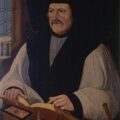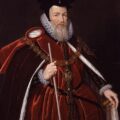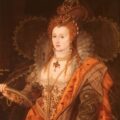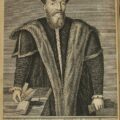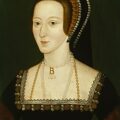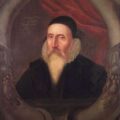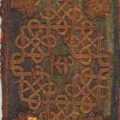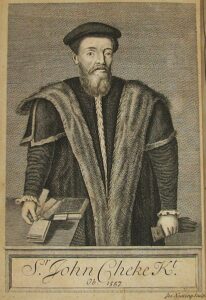
This is the second part of author Robert Parry’s examination of the “Cambridge Connections” which Anne Boleyn gave her daughter, the future Elizabeth I, when she asked her chaplain Matthew Parker to look after Elizabeth if anything should happen to her.
The Cambridge Connections – Part 2
by Robert Parry
In part two of this article on the “Cambridge Connections” we look a little more deeply into the lives of those involved and in their common purpose in helping Elizabeth continue the work of the humanist philosophers of the 16th century.
Archbishop Parker and William Cecil were life-long friends (though Cecil was younger). When Anne entrusted her daughter’s welfare and intellectual destiny to Parker, therefore, she was at the same time aligning herself with the very people who seem to have guided and protected Elizabeth during her most difficult days – during the dangerous and turbulent decade preceding her coronation, for example.
The Cambridge set associated with Cecil and Parker included three of Elizabeth’s earliest tutors, namely William Grindal, John Cheke and Roger Ascham, and also quite possibly a fourth, John Dee – educated in Greek, mathematics and astronomy at St. John’s, Cambridge and who is believed to have taught Edward VI and Robert Dudley. He was one of the most important players during the early years of Elizabeth’s reign and is famous for setting the date of her coronation according to astrological principles. Dee later became the architect of the burgeoning overseas Empire (he was the first to coin the term ‘British Empire’) and advised just about every one of the great Elizabethan seafarers and explorers on matters of navigation and geography. He was also associated with ideas and movements that strove towards reform and an enlightened, humanist approach towards seeking harmony between all religious persuasions. Numbered among his friends and colleagues were Cecil, Cheke and Ascham.
The children of Henry VIII (those born in wedlock, that is, and who each became a reigning monarch in their own time) tended to be taught by the Cambridge set, and in particular, in the case of Edward and Elizabeth, by those of a more reformed, humanist or protestant leaning. The Cambridge men would also be employed as tutors to children of the various noble families, ambassadors and privy councillors who were resident at court. Robert Dudley and Jane Grey, for example, were taught by the very same people who tutored Princess Elizabeth and the young King Edward. In the company of the two most important and influential women in the young Elizabeth’s life, namely Kat Ashley and Blanche Parry, these ‘gentlemen schoolmasters’ included Grindal, Cooke, Ascham, Cheke and (probably) John Dee at various times – all associates or friends of William Cecil and/or Matthew Parker. So the connections are plentiful and their significance impossible to ignore. There was almost certainly a common purpose and aim behind their work, and Elizabeth came to embody their aims and intellectual ambitions. This was the case even before she became Queen. It was apparently a jest at the time that Hatfield (her home as a young woman) was really an outpost of Cambridge University.
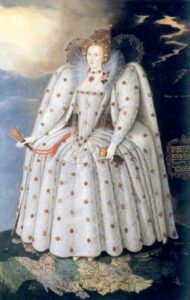
Sometimes it is not sufficiently appreciated in some quarters the extent of Elizabeth’s intellectual achievements and skills. She was not only accomplished in the sciences of mathematics, geography and astronomy – able to converse at the highest levels on these subjects with the scholars of the times – but was also fluent in six languages (French, Spanish, Italian, Latin, German and Greek, and even a little Welsh and Portuguese). Her capabilities as a writer of letters and poetry were considerable, and she was also a gifted musician, able to perform well on both the lute and virginals (an early form of keyboard instrument). She enjoyed and promoted drama at court and, even during the time of the Armada and the various plots against her at home, she was broad-minded and tolerant enough to allow herself to be a devotee and supporter of Catholic composers such as William Byrd – whom she encouraged and protected despite his religious persuasion. She was fascinated and curious about astronomy and alchemy, medicine and geometry. Yet for all her intellectual brilliance and devotion to lofty thoughts, the ring she wore to her dying day contained, when opened, miniature portraits of herself and her mother side by side. That was important to her, and there is surely good reason for it.
All of this tends to suggest that an ambitious reformist undercurrent was established early on in the Tudor era, and that Elizabeth’s mother, Queen Anne, would have been well-aware of it when she entrusted her child into the care of one of its leading lights. It is also, therefore, surely no exaggeration to say that the Elizabethan age (still known fondly as England’s golden age), was likely constructed upon the very same principles that people like Parker and Cecil embodied. Certainly, the statement made at the beginning of Elizabeth’s reign that she had no wish to open windows into men’s souls is a very good example of humanist ideals in practice. Yes, it had its darker side, the Elizabethan era, and it had its fair share of brutality – at a time and in an age when darkness and brutality were common place – but it also prized human dignity and the power of the intellect. It had a wonderful mood of optimism, a sense of adventure and artistic purpose, a striving towards excellence and a bold, swaggering kind of self-confidence that we can only envy and wonder at today.
I hope this article has demonstrated that Anne and Elizabeth might have been linked not just in their shared DNA but also in ways which run far deeper than is generally assumed and which were based on the highest human ideals. It certainly is an attractive thought to entertain.
Further Reading
Robert Parry has written a wonderful novel about Elizabeth and the Cambridge set of men who protected and helped her – Virgin and the Crab. It is a magical book and is, in my opinion, one of the best historical novels out there, I just couldn’t put it down! Read my review at http://reviews.theanneboleynfiles.com/the-virgin-and-the-crab-by-robert-parry/184 for more information on the book and its availability.
